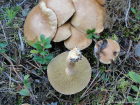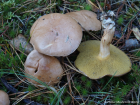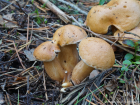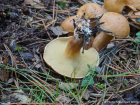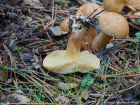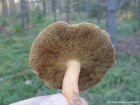Cap grey-yellow or ochre with a pink tinge, initially convex, then flat with a wavy margin. The flesh is spongy and rubbery, whitish, yellowish or clay-coloured and has a fruity smell. Pores at first pallid olive or buff, becoming more ochraceous with age, angular, compound, unequal, and large. The tubes are sometimes slightly decurrent to the stem. Stem pallid yellowish sienna, more or less equal or tapering at the base. Unlike many members of the Suillus genus, it does not have a stem ring. Spore print olive-green or brown.
Microscopic Features: The spores are smooth and subfusiform, measuring 8-10μm in length and 3-4μm in width.
Suillus bovinus on the www.first-nature.com web site.
Many mushrooms are poisonous, and some can be lethally toxic. Distinguishing between edible and poisonous mushrooms can be very challenging. Therefore, we strongly advise against consuming wild mushrooms. This website does not contain any information about the edibility or toxicity of mushrooms.
Although efforts have been made to ensure accuracy on this website, the information may contain errors and omissions. Therefore, all content provided is for educational and informational purposes only and should not be relied upon or used as a basis for consuming any plants or mushrooms.
External links are provided for reference only. We do not endorse or take responsibility for the content, advice, or products found on these sites or in any advertisements shown on this website.
